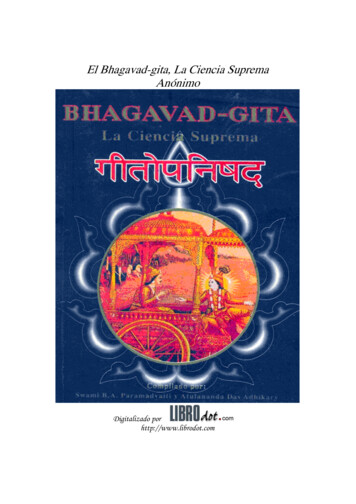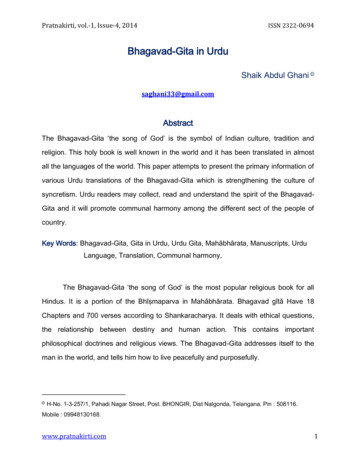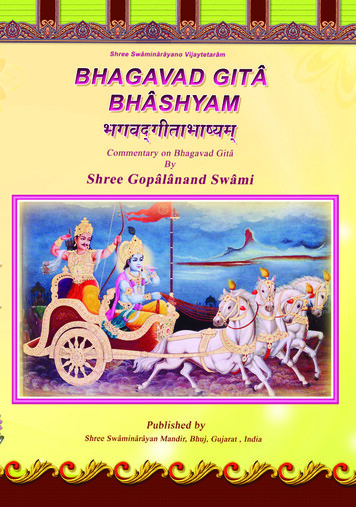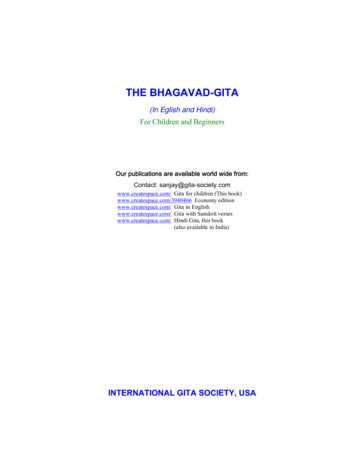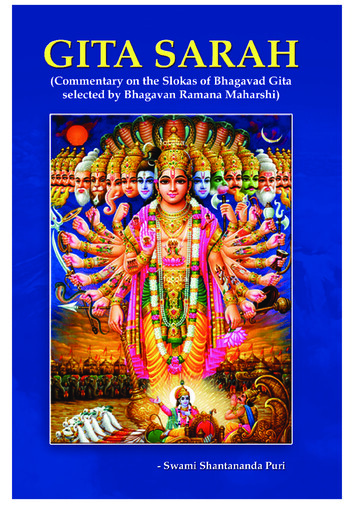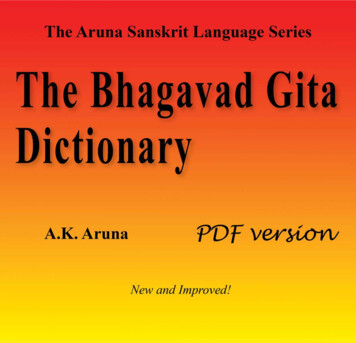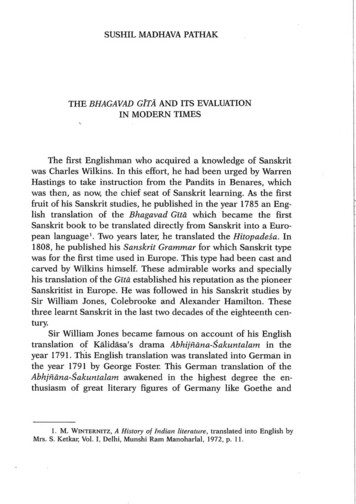
Transcription
Continue
Bhagavad gita shankara bhashya kannada pdf hindi online free Hiltebeitel 2002. According to Upadhyaya, the Gita states that none of these paths to spiritual realization is "intrinsically superior or inferior", rather they "converge in one and lead to the same goal".[86] According to Hiltebeitel, Bhakti forms an essential ingredient of this synthesis, and the text incorporates Bhakti into Vedanta.[87] According toScheepers, The Bhagavad Gita is a Brahmanical text which uses the shramanic and Yogic terminology to spread the Brahmanic idea of living according to one's duty or dharma, in contrast to the ascetic ideal of liberation by avoiding all karma.[88] According to Galvin Flood and Charles Martin, the Gita rejects the shramanic path of non-action,emphasizing instead "the renunciation of the fruits of action".[89] The Bhagavad Gita, states Raju, is a great synthesis of the ideas of the impersonal spiritual monism with personal God, of "the yoga of action with the yoga of transcendence of action, and these again with yogas of devotion and knowledge".[11] Manuscripts A 19th-century Sanskritmanuscript of the Bhagavad Gita, Devanagari script The Bhagavad Gita manuscript is found in the sixth book of the Mahabharata manuscripts – the Bhisma-parvan. American Sociological Review. Eons end, everything dissolves and then he recreates another eon subjecting them to the laws of Prakriti (nature).[140] He equates himself to being thefather and the mother of the universe, to being the Om, to the three Vedas, to the seed, the goal of life, the refuge and abode of all. van Buitenen too states that the Gita was likely composed about 200 BCE.[40] According to the Indologist Arvind Sharma, the Gita is generally accepted to be a 2nd-century-BCE text.[41] A manuscript illustration of thebattle of Kurukshetra, fought between the Kauravas and the Pandavas, recorded in the Mahabharata. Structural Depths of Indian Thought. Minor 1986, pp. 38–39, 123–128, 143. ISBN 978-1-136-85306-7. pp. xxv–xxvii. a b c d Minor 1982, pp. l–li, Quote: "The current text of the Bhagavad Gita is well-preserved with relatively few variant readingsand none quite serious. p. 215. pp. 79–81, 87–88. 12 (7): 16–23. A karma yogi finds such work inherently fulfilling and satisfying.[187] To a karma yogi, right work done well is a form of prayer,[188] and karma yoga is the path of selfless action.[189] According to Mohandas Karamchand Gandhi, the object of the Gita is to show the way to attain selfrealization, and this "can be achieved by selfless action, by desireless action; by renouncing fruits of action; by dedicating all activities to God, i.e., by surrendering oneself to Him body and Self." Gandhi called the Gita "The Gospel of Selfless Action".[190] According to Jonardon Ganeri, the premise of "disinterested action" is one of the importantethical concepts in the Gita.[191] Bhakti yoga Main article: Bhakti yoga How a Gita recitation sounds? Ganesh: Studies of an Asian God. ISBN 978-1-134-27891-6. In light of the Ahimsa (non-violence) teachings in Hindu scriptures, the Gita has been criticized as violating the Ahimsa value, or alternatively, as supporting political violence.[385] Thejustification of political violence when peaceful protests and all else fails, states Varma, has been a "fairly common feature of modern Indian political thought" along with the "mighty antithesis of Gandhian thought on non-violence". "The Bhagavad Gita as Way-Shower to the Transcendental". M.V. Nadkarni (2016). Fowler 2012, pp. 50–63, 66–70. David Slavitt (2015). (Dry Bones Press, San Francisco, 1998) ISBN 1-883938-47-3. Advaita Ashram. White, David (1971). Retrieved 2 November 2020. Moral Passion and Christian Ethics. Southgate 2005, p. 246. Garrett, John; Wilhelm, Humboldt, eds. Ambedkar, born in a Dalit family and the principal architect of the Constitution of India,criticized the text for its stance on caste and for "defending certain dogmas of religion on philosophical grounds".[361] According to Jimmy Klausen, Ambedkar in his essay Krishna and his Gita stated that the Gita was a "tool" of Brahmanical Hinduism and for its latter-day saints such as Mahatma Gandhi and Lokmanya Tilak. Osmund Bopearachchi,Emergence of Viṣṇu and Śiva Images in India: Numismatic and Sculptural Evidence, 2016. Miller 1986, p. 63. The Gita is a cohesively knit pedagogic text, not a list of norms.[375] Modern-Hinduism Novel interpretations of the Gita, along with apologetics on it, have been a part of the modern era revisionism and renewal movements withinHinduism.[376] Bankim Chandra Chatterji, the author of Vande Mataram – the national song of India, challenged orientalist literature on Hinduism and offered his interpretations of the Gita, states Ajit Ray.[377][216] Bal Gangadhar Tilak interpreted the karma yoga teachings in Gita as a "doctrine of liberation" taught by Hinduism,[378] whileSarvepalli Radhakrishnan stated that the Bhagavad Gita teaches a universalist religion and the "essence of Hinduism" along with the "essence of all religions", rather than a private religion.[379] Vivekananda's works contained numerous references to the Gita, such as his lectures on the four yogas – Bhakti, Jnana, Karma, and Raja.[380] Through themessage of the Gita, Vivekananda sought to energise the people of India to reclaim their dormant but strong identity.[381] Aurobindo saw Bhagavad Gita as a "scripture of the future religion" and suggested that Hinduism had acquired a much wider relevance through the Gita.[382] Sivananda called Bhagavad Gita "the most precious jewel of Hinduliterature" and suggested its introduction into the curriculum of Indian schools and colleges.[383] According to Ronald Neufeldt, it was the Theosophical Society that dedicated much attention and energy to the allegorical interpretation of the Gita, along with religious texts from around the world, after 1885 and given H. The battle, a perennial one, isbetween the power of good and the power of evil. pp. 82–83 (Part 2), 149–153 (Part 1). Ritz Magazine. (2006), Interpretations of the Bhagavad-Gītā and Images of the Hindu Tradition: The Song of the Lord, Routledge, ISBN 978-0-415-34671-9 Sampatkumaran, M.R. (1985), The Gītābhāṣya of Rāmānuja, Bombay: Ananthacharya Indological ResearchInstitute Sargeant, Winthrop (2009), Christopher Key Chapple (ed.), The Bhagavad Gītā: Twenty-fifth Anniversary Edition, State University of New York Press, ISBN 978-1-4384-2841-3 Kenneth Schouler; Susai Anthony (2009). pp. 9–11. In Bhagavad Gita, similarly, 'Krishna identified himself both with Vāsudeva, Vishnu and their meanings'.[246][note18] The ideas at the center of Vedic rituals in Shatapatha Brahmana and the teachings of the Bhagavad Gita revolve around this absolute Person, the primordial genderless absolute, which is same as the goal of Pancaratra Agama and Tantra.[248] Translations The first English translation of the Bhagavad Gita was published by Charles Wilkins in1785.[249] The Wilkins translation had an introduction to the Gita by Warren Hastings. pp. 79–81, 88. Easwaran 2007, pp. 133–146. Jayaram 2000 Bhagavad Gita: A Walkthrough for Westerners Jack Hawley 2001 Bhagavad Gita[note 31] Rosetta Williams 2001 The Bhagavad Gita of Order Anand Aadhar Prabhu 2001 Bhagavad Gita: The Song DivineCarl E. Hudson 2002, p. 133. a b Minor 1982, pp. l–ii. For Vivekananda, the Gita was an egalitarian scripture that rejected caste and other hierarchies because of its verses such as 13.27—28, which states "He who sees the Supreme Lord dwelling equally in all beings, the Imperishable in things that perish, he sees verily. Doranne Jacobson;Eleanor Zelliot; Susan Snow Wadley (1992). [a] Anatta, Encyclopædia Britannica (2013), Quote: "Anatta in Buddhism, the doctrine that there is in humans no permanent, underlying Self. The Everything Hinduism Book: Learn the traditions and rituals of the "religion of peace". J. a b Easwaran 2007, pp. 221–228. The Concealed Art of the Soul:Theories of Self and Practices of Truth in Indian Ethics and Epistemology. a b Easwaran 2007, pp. 191–202. a b Zaehner 1969, pp. 13–15, 254. pp. 126–127. Chidbhavananda 1997, p. 33 Chinmayananda 1998, p. 3 Ranganathananda 2000, pp. 15–25 a b c d e f g h i j k l m n o p q r Easwaran 2007, pp. 5–6. Krishna discusses the nature ofGod, according to Easwaran, wherein Krishna not only transcends impermanent body (matter), he also transcends the atman (Self) in every being.[157] According to Franklin Edgerton, the verses in this chapter in association with select verses in other chapters make the metaphysics of the Gita to be dualistic. Hudson 2002, pp. 156–157. Further,he states that the Mahabharata has numerous such interpolations and inserting the Gita would not be unusual.[35] In contrast, the Indologist James Fitzgerald states, in a manner similar to van Buitenen, that the Bhagavad Gita is the centerpiece and essential to the ideological continuity in the Mahabharata, and the entire epic builds up to thefundamental dharma questions in the Gita. The Bhagavad Gīta Explained. a b c d e Scheepers 2000. p. 78. a b c d e f g h i j k l m n o p q r Maitra 2018, pp. vii–viii. a b c d e f g h i j k l m n o p q r s t translated by Sir Edwin Arnold (1885), Bhagavadgita (Unabridged ed.), New York: Dover Publications (1993 Reprint), ISBN 0-486-27782-8 Catherine Cornille (2006). Westminster John Knox Press. Sahadeo 2011, p. 129 harvnb error: no target: CITEREFSahadeo2011 (help) Londhe 2008, p. 191 "Dr Kalam, India's Most Non-Traditional President". George Thompson (2008). pp. 13–14. R.D. Ranade (1997). To render it in English for non-Hindus for its better understanding, onemust ask what is the sva-dharma for the non-Hindus? Robert Oppenheimer,[336] Ralph Waldo Emerson, Carl Jung, Herman Hesse,[337][338] and Bülent Ecevit.[339] At a time when Indian nationalists were seeking an indigenous basis for social and political action against colonial rule, Bhagavad Gita provided them with a rationale for their activismand fight against injustice.[340] Bal Gangadhar Tilak and Mahatma Gandhi used the text to help inspire the Indian independence movement.[note 35][note 36] Mahatma Gandhi expressed his love for the Gita in these words: I find a solace in the Bhagavadgītā that I miss even in the Sermon on the Mount. Susan Bayly (2001). Iyer won the 1993National Film Award for Best Film.[web 7][web 8] The 1995 novel by Steven Pressfield, and its adaptation as the 2000 golf movie The Legend of Bagger Vance by Robert Redford has parallels to the Bhagavad Gita, according to Steven J. It considers this transient reality as Maya. Mahadeva Sastry 1897 Young Men's Gita Jagindranath Mukharji 1900Bhagavadgita: The Lord's Song L.D. Barnett 1905 Bhagavad Gita[note 23] Anne Besant and Bhagavan Das 1905 Die Bhagavadgita Richard Garbe 1905 Srimad Bhagavad-Gita Swami Swarupananda 1909 Der Gesang des Heiligen Paul Deussen 1911 Srimad Bhagavad-Gita Swami Paramananda 1913 La Bhagavad-Gîtâ Emile Sénart 1922 The BhagavadGita according to Gandhi[note 24] Mohandas K. Gauḍīya Vaiṣṇava Commentaries Chaitanya Mahaprabhu (b. This chapter of the Gita, states Easwaran, offers a "vastly easier" path to most human beings to identify and love God in an anthropomorphic representation, in any form.[147] He can be projected as "a merciful father, a divine mother, a wisefriend, a passionate beloved, or even a mischievous child", according to Easwaran. It re-emphasizes the karma-phala-tyaga teaching, or "act while renouncing the fruits of your action".[164] Chapters summary Chapter Title Verses 1 Arjuna's Vishada Yoga 47 2 Sankhya Yoga 72 3 Karma Yoga 43 4 Jnana-Karma-Sanyasa Yoga 42 5 Karma-Sanyasa Yoga29 6 Atma-Samyama Yoga 47 7 Jnana-Vijnana Yoga 30 8 Aksara-ParaBrahma Yoga 28 9 Raja-Vidya-Raja-Guhya Yoga 34 10 Vibhuti Yoga 42 11 Viswarupa-Darsana Yoga 55 12 Bhakti Yoga 20 13 Ksetra-Ksetrajna-Vibhaga Yoga 34 14 Gunatraya-Vibhaga Yoga 27 15 Purushottama Yoga 20 16 Daivasura-Sampad-Vibhaga Yoga 24 17 ShraddhatrayaVibhaga Yoga 28 18 Moksha-Sanyasa Yoga 78 Total 700 Themes Chapter 11 of the Gita refers to Krishna as Vishvarupa (above). With Arjuna is Krishna, not as a participant in the war, but only as his charioteer and counsel. 1), vol. 1, Calcutta: Advaita Ashrama, ISBN 81-7505-213-9 Rao, Vasudeva (2002), Living Traditions in Contemporary Contexts:The Madhva Matha of Udupi, Orient Blackswan, ISBN 978-81-250-2297-8 Robinson, Catherine A. Business Standard. Sachindra Kumar Majumdar (1991). a b c Sargeant 2009, pp. x–xviii. 1885. Malinar 2007, pp. 36–39. —Bhagavad Gita 6.1Eknath Easwaran[130][note 14] Chapter 6: Dhyanayoga (Aatmasamyamyoga) (47 verses) Sometranslators title the sixth chapter as Dhyana yoga, Religion by Self-Restraint, The Practice of Meditation, or The Yoga of Meditation.[18][114][115] The chapter opens as a continuation of Krishna's teachings about selfless work and the personality of someone who has renounced the fruits that are found in chapter 5. Fowler 2012, p. xxxvi. (2000).Steven Pressfield acknowledges that the Gita was his inspiration, the golfer character in his novel is Arjuna, the caddie is Krishna, states Rosen. "Kalam And Islam". Sharma 1986, pp. xv–xvi. a b see "The Mahabharata (Electronic text)". Winternitz, Maurice (1972), History of Indian Literature, New Delhi: Oriental Books Wood, Ernest (1954).[98] Each shloka consists of a couplet, thus the entire text consists of 1,400 lines. 1078–79, is cited from Radhakrishnan 1993 Front matter. 28 February 2021. In 1849, the Weleyan Mission Press, Bangalore published The Bhagavat-Geeta, Or, Dialogues of Krishna and Arjoon in Eighteen Lectures, with Sanskrit, Canarese and English in parallelcolumns, edited by Rev. Theological Studies. But there is this much of truth in the view, that the setting of the doctrine though not symbolical, is certainly typical.[235] Other parallelism include verse 10.21 of Gita replicating the structure of verse 1.2.5 of the Shatapatha Brahmana.[247] Sanskrit scholar Barbara Stoler Miller produced atranslation in 1986 intended to emphasise the poem's influence and current context within English Literature, especially the works of T.S. Eliot, Henry David Thoreau and Ralph Waldo Emerson.[257] The translation was praised by scholars as well as literary critics.[258][259] Similarly, the Hinduism scholar Jeaneane Fowler's translation and studenttext has been praised for its comprehensive introduction, quality of translation, and commentary.[260] Second edition in 1898 Or Bhagavat-Gita, Edwin Arnold, reprinted by Dover Publications, New York, 1900 Reprinted by Theosophical University Press, Los Angeles, California, 1967 Reprinted by Theosophical Publishing House, Los Angeles,California, 1987 Eventually published by Navajivan Publishing House, Ahmedabad, 1946. Harvard University Press. Shankara and Indian Philosophy. "Thoughts on the Gita". Robert Charles Zaehner (1973). The Bhagavad Gita: The Songs of the Master. {{cite book}}: author2 has generic name (help) a b Zaehner 1969, p. 3 a b c Flood1996, p. 124 Alladi Mahadeva Sastry (1980). ISBN 978-0-674-06728-8. Fowler 2012, pp. 100, 118–119. Minor 1986, pp. 44–57. 2 (3): 254–258. Framarin (2006). The Gita text he commented on is a slightly different recension than the one of Adi Shankara. Singh 2006, p. 55 W. Oxford University Press. Krishnananda, (Swami.) (1980), ThePhilosophy of the Bhagavadgita, The Divine Life Society, ISBN 978-81-7052-077-1 Londhe, Sushama (2008), A tribute to Hinduism: thoughts and wisdom spanning continents and time about India and her culture, Pragun Publication, ISBN 978-81-89920-66-1 Mahesh Yogi, Maharishi (1990). Sharma 1986, pp. xvi–xxvii. Gita Vahini Stream of DivineSong. Robert Oppenheimer". JSTOR 1515629. Easwaran 2007, pp. 211–220. A synthesis of knowledge, devotion, and desireless action is offered by Krishna as a spectrum of choices to Arjuna; the same combination is suggested to the reader as a way to moksha.[239] Christopher Chapple – a Comparative Theology scholar focusing on Indianreligions, in Winthrop Sargeant translation of the Gita, states, "In the model presented by the Bhagavad Gītā, every aspect of life is in fact a way of salvation."[240] Pancaratra Agama Vāsudeva-Krishna, on a coin of Agathocles of Bactria, c. 180 BCE.[241][242] This is "the earliest unambiguous image" of the deity.[243] According to Dennis Hudson,there is an overlap between Vedic and Tantric rituals with the teachings found in the Bhagavad Gita.[244] He places the Pancaratra Agama in the last three or four centuries of 1st-millennium BCE, and proposes that both the tantric and vedic, the Agama and the Gita share the same Vāsudeva-Krishna roots.[245] Some of the ideas in the BhagavadGita connect it to the Shatapatha Brahmana of Yajurveda. ISBN 978-1-4384-1687-8. Gordon Melton (2011). Nilgiri Press. p. 187. ISBN 978-1-135-14383-1. Adams Media. p. 4. The Bhagavad Gita: A New Translation. The Mahabharata – the world's longest poem – is itself a text that was likely written and compiled over several hundred years, one datedbetween "400 BCE or little earlier, and 2nd century CE, though some claim a few parts can be put as late as 400 CE", states Fowler. They are free within, always.[128][129] Chapter 5 shows signs of interpolations and internal contradictions. Sargeant 2009, pp. xxiii–xxiv. Miller 1986, pp. 14–17 Bloom 1995, p. 531 Doniger, Wendy (August1993), "Obituary: Barbara Stoler Miller", Journal of Asian Studies, 52 (3): 813–15, doi:10.1017/S002191180003789X, JSTOR 2058944 Arvind Sharma (2014), Review: Three New Books on the "Bhagavad Gītā", International Journal of Hindu Studies, Vol. ISBN 978-0-87612-033-0. Fowler 2012, p. 2 Krishnananda 1980, pp. 12–13 Easwaran2007, p. 15. Action leads to knowledge, while selfless action leads to spiritual awareness, state the last verses of this chapter.[3] The 4th chapter is the first time where Krishna begins to reveal his divine nature to Arjuna.[125][126] Chapter 5: Karma Sanyasayoga (29 verses) Some translators title this chapter as Karma–Sanyasa yoga, Religion byRenouncing Fruits of Works, Renounce and Rejoice, or The Yoga of Renunciation.[18][114][115] The chapter starts by presenting the tension in the Indian tradition between the life of sannyasa (monks who have renounced their household and worldly attachments) and the life of grihastha (householder). He also says that he is Rama when he says,"Among the wielders of weapons, I am Rama". Jan Gonda (1935). "Review: 'The Teachings of Bhagavad Gita' by Richa Tilokani". Maitra 2018, pp. 5, 26–30, 143. Arjuna, one of the five Pandavas Krishna, Arjuna's charioteer and guru who was actually an incarnation of Vishnu Sanjaya, counselor of the Kuru king Dhritarashtra (secondary narrator)Dhritarashtra, Kuru king (Sanjaya's audience) and father of the Kauravas Chapters Bhagavad Gita comprises 18 chapters (section 23 to 40)[109][web 2] in the Bhishma Parva of the epic Mahabharata. pp. 50–58. BRILL. Olcott, Mason (1944). The text states that Dasasloki—possibly authored by Nimbarka—teaches the essence of the Gita; the Gitatattva prakashika interprets the Gita also in a hybrid monist-dualist manner.[297][298] Vallabha (1481–1533 CE) Vallabha, the proponent of "Suddhadvaita" or pure non-dualism, wrote a commentary on the Gita, the Sattvadipika. Weiser. a b c Sargeant 2009, p. 8. A. This was later published in 2011 in a new edition and nine volume format.[330]Galyna Kogut and Rahul Singh published An Atheist Gets the Gita, a 21st-century interpretation of the 5,000-year-old text.[331] Reception Narendra Modi, the 14th prime minister of India, called the Bhagavad Gita "India's biggest gift to the world".[332] Modi gave a copy of it to the then President of the United States of America, Barack Obama in2014 during his U.S. visit.[333] With its translation and study by Western scholars beginning in the early 18th century, the Bhagavad Gita gained a growing appreciation and popularity.[web 1] According to the Indian historian and writer Khushwant Singh, Rudyard Kipling's famous poem "If—" is "the essence of the message of The Gita in English."[334] Praise and popularity Main article: Influence of Bhagavad Gita The Bhagavad Gita has been highly praised, not only by prominent Indians including Mahatma Gandhi and Sarvepalli Radhakrishnan,[335] but also by Aldous Huxley, Henry David Thoreau, J. The author is listed as M.K. Gandhi; Mahadev Desai, translator. Kolkota. 38. "BhagavadGita in Braille Language". Hacker & Halbfass 1995, p. 268. The Bhagavadgita in the Mahabharata. Modern-era commentaries Among notable modern commentators of the Bhagavad Gita are Bal Gangadhar Tilak, Vinoba Bhave, Mahatma Gandhi (who called its philosophy Anasakti Yoga), Sri Aurobindo, Sarvepalli Radhakrishnan, B. ISBN 978-81208-0576-7. The setting of the Gita in a battlefield has been interpreted as an allegory for the ethical and moral struggles of human life.[5][7][8] The Bhagavad Gita presents a synthesis[9][10] of Hindu ideas about dharma,[9][10][11] theistic bhakti,[11][12] and the yogic ideals[10] of moksha.[10] The text covers Jñāna, Bhakti, Karma, and Rāja yogas(spoken of in the 6th chapter),[12] incorporating ideas from the Samkhya-Yoga philosophy.[web 1][note 2] The Bhagavad Gita is the best known and most famous of Hindu texts,[13] and has a unique pan-Hindu influence.[14][15] The Gita's call for selfless action inspired many leaders of the Indian independence movement including Bal GangadharTilak and Mahatma Gandhi, the latter referring to it as his "spiritual dictionary".[16] Part of a series onHindu scriptures and texts Shruti Smriti List Vedas Rigveda Samaveda Yajurveda Atharvaveda Divisions Samhita Brahmana Aranyaka Upanishads UpanishadsRig vedic Aitareya Kaushitaki Sama vedic Chandogya Kena Yajur vedic BrihadaranyakaIsha Taittiriya Katha Shvetashvatara Maitri Atharva vedic Mundaka Mandukya Prashna Other scriptures Bhagavad Gita Agamas Related Hindu texts Vedangas Shiksha Chandas Vyakarana Nirukta Kalpa Jyotisha PuranasBrahma puranas Brahma Brahmānda Brahmavaivarta Markandeya Bhavishya Vaishnava puranas Vishnu Bhagavata NaradiyaGaruda Padma Vamana Varaha Purana Kurma Matsya Shaiva puranas Shiva Linga Skanda Vayu Agni Shakta puranas Devi Bhagavata Itihasa Ramayana Historicity Mahabharata Historicity Sangam Literature Saiva Tirumurai Divya Prabandham Tirumurukāṟṟuppaṭai Thiruppugazh Tirukkuṟaḷ Kamba Ramayanam Five Great Epics Eighteen GreaterTexts Eighteen Lesser Texts Aathichoodi Iraiyanar Akapporul Abhirami Anthadhi Thiruvilaiyadal Puranam Vinayagar Agaval Shastras and Sutras Dharma Shastra Artha Shastra Kamasutra Brahma Sutras Samkhya Sutras Mimamsa Sutras Nyāya Sūtras Vaiśeṣika Sūtra Yoga Sutras Pramana Sutras Charaka Samhita Sushruta Samhita Natya ShastraVastu Shastra Panchatantra Divya Prabandha Tirumurai Ramcharitmanas Yoga Vasistha Swara yoga Shiva Samhita Gheranda Samhita Panchadasi Vedantasara Stotra Timeline Chronology of Hindu texts vte Nomenclature The Gita in the title of the Bhagavad Gita means "song". During the independence movement in India, Hindus considered active"burning and drowning of British goods" while technically illegal under colonial legislation, were viewed as a moral and just war for the sake of liberty and righteous values of the type Gita discusses.[386] According to Paul Schaffel the influential Hindu nationalist V.D. Savarkar "often turned to Hindu scripture such as the Bhagavad Gita, arguing thatthe text justified violence against those who would harm Mother India."[387] Mahatma Gandhi credited his commitment for ahimsa to the Gita. Spirituality and Indian Psychology: Lessons from the Bhagavad-Gita. 33, Quote: "The dispute with Buddhists, who do not accept an imperishable Self, gives the Atman schools [Vedanta, Kashmir Shaivism] achance to articulate the intellectual aspects of their way to meditative liberation". pp. 30–35, 41–47 with footnotes. Some Sanskrit editions that separate the Gita from the epic as an independent text, as well as translators, however, add chapter titles such as each chapter being a particular form of yoga.[110][web 3] For example, SwamiChidbhavananda describes each of the eighteen chapters as a separate yoga because each chapter, like yoga, "trains the body and the mind". ISBN 978-0-521-60401-7. Hijiya, James A. Gandhi 2009, pp. xv–xxiv Jonardon Ganeri (2007). Some translators title the chapter as Sankhya Yoga, The Book of Doctrines, Self-Realization, or The Yoga ofKnowledge (and Philosophy).[18][114][115] The second chapter begins the philosophical discussions and teachings found in Gita. doi:10.1177/004056397703800204. pp. 101–104. This knowledge leads to the universal, transcendent Godhead, the divine essence in all beings, to Brahman – the Krishna himself. ISBN 978-1-4384-1325-9. It has 18chapters in total. Back to Godhead. Brill Academic. doi:10.1353/pew.2006.0051. pp. 11–12, 213. Jacob Neusner (ed.). Song Divine: Christian Commentaries on the Bhagavad Gītā. The Gita accepts atman as the pure, unchanging, ultimate real essence, experiencer of one's being.[179] The nature of the world The Gita considers the world to betransient, all bodies and matter as impermanent. "Mahabharata in Art and Literature in Thailand". Minor 1986, p. 131 Minor 1986, p. 144 Robinson 2006, p. 69 Robinson 2006, p. 102 a b Minor 1986, pp. 11–14. ISBN 978-0-19-803400-1. p. xxi. "Brazil's Amazonia-1 on board with Bhagavad Gita". Alexus McLeod (2014). Some translatorstitle this chapter as Ksetra–Ksetrajna Vibhaga yoga, Religion by Separation of Matter and Spirit, The Field and the Knower, or The Yoga of Difference between the Field and Field-Knower.[18][114][115] The chapter opens with Krishna continuing his discourse from the previous chapter. Essence of the Bhagavad Gita: A Contemporary Guide to Yoga,Meditation, and Indian Philosophy. Krishna replies that there is no way to avoid action (karma), since abstention from work is also an action.[122] Krishna states that Arjuna has an obligation to understand and perform his duty (dharma), because everything is connected by the law of cause and effect. The number of stanzas in the Gita is 700, anumber confirmed by Shankara, and possibly deliberately chosen in order to prevent interpolations." Gambhirananda 1997, p. xvii. 4, No. 1 (1926), pp. Nimbarka (1162 CE) followed Bhaskara, but it is unclear if he ever wrote a commentary. Baba, Sathya Sai (2010). It is considered to be one of the holy scriptures for Hinduism. In the literature, thequote usually appears in the form shatterer of worlds, because this was the form in which it first appeared in print, in Time magazine on 8 November 1948.[351] It later appeared in Robert Jungk's Brighter than a Thousand Suns: A Personal History of the Atomic Scientists (1958),[349] which was based on an interview with Oppenheimer. Sargeant2009, p. xxv. a b Easwaran 2007, pp. 157–168. Therein, in the third section, the Gita forms chapters 23–40, that is 6.3.23 to 6.3.40.[90] The Bhagavad Gita is often preserved and studied on its own, as an independent text with its chapters renumbered from 1 to 18.[90] The Bhagavad Gita manuscripts exist in numerous Indic scripts.[91] Theseinclude writing systems that are currently in use, as well as early scripts such as the Sharada script, now dormant.[91][92] Variant manuscripts of the Gita have been found on the Indian subcontinent[64][93] Unlike the enormous variations in the remaining sections of the surviving Mahabharata manuscripts, the Gita manuscripts show only minorvariations and the meaning is the same.[64][93] According to Gambhirananda, the old manuscripts may have had 745 verses, though he agrees that 700 verses is the generally accepted historic standard.[94] Gambhirananda's view is supported by a few versions of chapter 6.43 of the Mahabharata. pp. xi–xv. The Origins and Development of ClassicalHinduism. However, its composite nature also leads to varying interpretations of the text and historic scholars have written bhashya (commentaries) on it.[279] According to Mysore Hiriyanna, the Gita is "one of the hardest books to interpret, which accounts for the numerous commentaries on it—each differing from the rest in one essential point orthe other".[280] According to Richard Davis, the Gita has attracted much scholarly interest in Indian history and some 227 commentaries have survived in the Sanskrit language alone.[281] It has also attracted commentaries in regional vernacular languages for centuries, such as the one by Sant (Saint) Dnyaneshwar in Marathi language (13thcentury).[282] Classical commentaries The Bhagavad Gita is referred to in the Brahma Sutras, and numerous scholars including Shankara, Bhaskara, Abhinavagupta of Shaivism tradition, Ramanuja and Madhvacharya wrote commentaries on it.[283][284] Many of these commentators state that the Gita is "meant to be a moksa-shastra (moksasatra),and not a dharmasastra, an arthasastra or a kamasastra", states Sharma.[285] Śaṅkara (c. Motilal Banarsidass. Phillips (2009). pp. Book one the first, page 19. Jnana yoga is the path of knowledge, wisdom, and direct realization of the Brahman.[196][197] In the Bhagavad Gita, it is also referred to as buddhi yoga and its goal is self-realization.[198]The text states that this is the path that intellectuals tend to prefer.[199] The chapter 4 of the Bhagavad Gita is dedicated to the general exposition of jnana yoga.[200][201] The Gita praises the path, calling the jnana yogin to be exceedingly dear to Krishna, but adds that the path is steep and difficult.[202] Synthesis of yogas, Raja yoga Sivananda'scommentary regards the eighteen chapters of the Bhagavad Gita as having a progressive order, by which Krishna leads "Arjuna up the ladder of Yoga from one rung to another."[203] The influential commentator Madhusudana
Sivananda called Bhagavad Gita "the most precious jewel of Hindu literature" and suggested its introduction into the curriculum of Indian schools and colleges.[383] According to Ronald Neufeldt, it was the Theosophical Society that dedicated much attention and energy to the allegorical interpretation of the Gita, along with religious texts from around the world, after 1885 and given H. The battle, a perennial one, is
